Menus
- Part 1: Country Road
- V-engine gives way to a parallel twin
- The new Honda Africa Twin has a narrow waist
- Easy controllability in every situation
- DCT version almost 10 kilograms heavier
- Soft springs, soft basic tuning
- Honda Africa Twin goes for understatement
- History Africa Twin

Honda
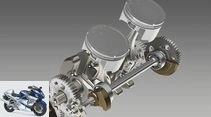
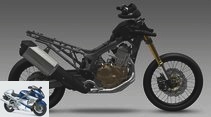
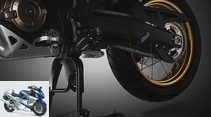
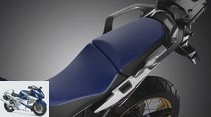
13 photos
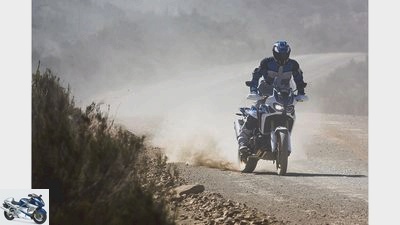
ULA SERRA PRATS
1/13
Honda Africa Twin.
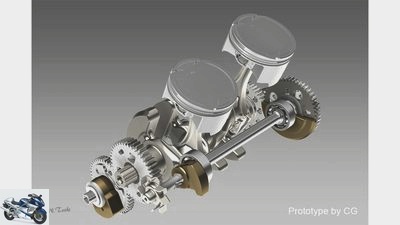
2/13
270 degree crank pin offset, long, continuous shaft with two balance weights in front of the crankshaft, the other balance shaft below on the oil pump drive.
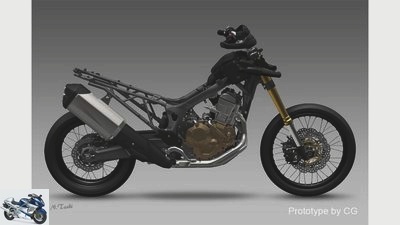
Honda
3/13
Clearly seen how Honda successfully sought to centralize the masses and keep the center of gravity low. The battery sits close to the center of gravity behind the cylinder bank, and the engine is bolted to the frame at six points.
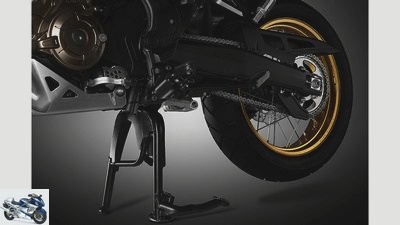
Emanuele Bella
4/13
Honda Africa Twin.
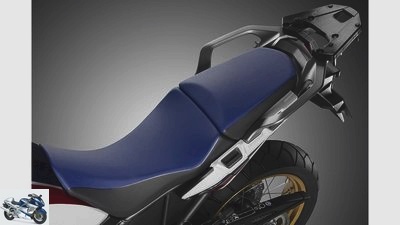
Emanuele Bella
5/13
The narrow waist at the transition between the tank and the bench keeps the step length low and ensures good knee closure when off-road.
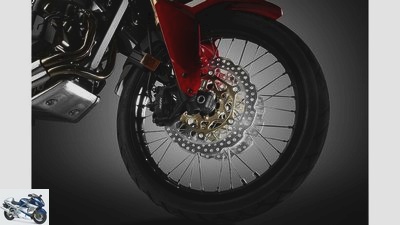
Emanuele Bella
6/13
The machine is equipped with spoked wheels in classic enduro dimensions: 18 inches at the rear and 21 inches at the front.
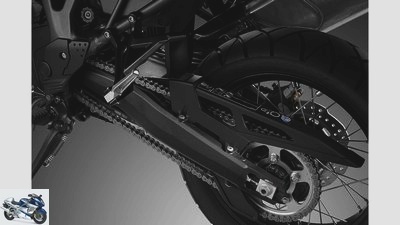
Emanuele Bella
7/13
Honda Africa Twin.
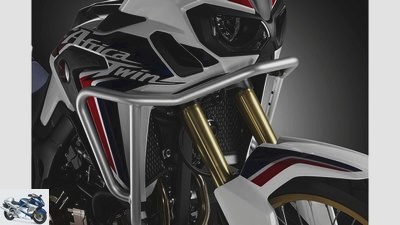
Emanuele Bella
8/13
No savings were made on the chassis. The spring elements are completely adjustable at the front and rear.
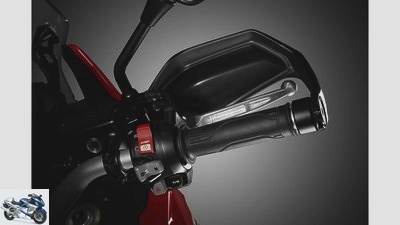
Emanuele Bella
9/13
On the right, the DCT modes can be switched and you can choose between automatic and manual mode.
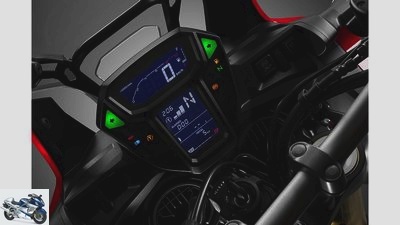
Emanuele Bella
10/13
Clear and logical arrangement, reasonably easy to read; the tachometer supplies reference values at best.
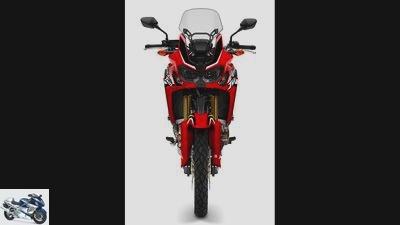
11/13
Rear and front lamps with LED technology, the windshield rigidly attached and rear-ventilated through special channels.
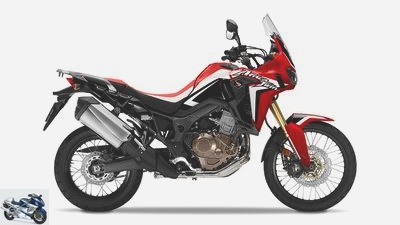
12/13
The Africa Twin looks quite slim from the front and from the side, despite being around 230 kilograms.
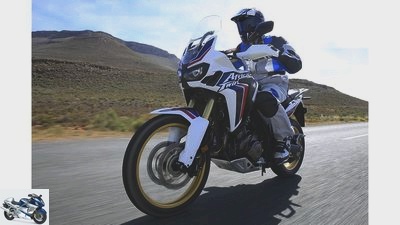
Manufacturer
13/13
Honda Africa Twin.
Honda CRF 1000 L Africa Twin in the driving report
Part 1: Country Road
Honda presented in Africa – where else? – the new Honda Africa Twin. Was it worth the wait? In the first part of the test it goes over winding passes and almost endless asphalt straights near Cape Town, in the second part then into the terrain.
A lot is cult today. Especially that which somehow stood out from the crowd at some point. Sometimes you ask yourself: why? Certainly not in the case of the Honda Africa Twin, which was already considered something special in its day. It is rather unusual that it did not shine with superlatives like many other real or supposed motorcycle legends. On the contrary, the paper form offered the A.frica Twin rather average. It wasn’t particularly strong on the road when it hit the market in 1988 as the XRV 650 with an initially slack 50 horsepower. It was not even a jumping field in the area with a live weight of 220 kilograms.
Buy complete article
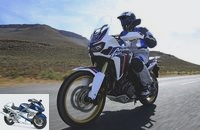
Honda CRF 1000 L Africa Twin in the driving report
Part 1: Country Road
Anyone expecting something sensational will be disappointed
So big footsteps that the Honda CRF 1000 L Africa Twin wants to follow today. It took Honda a correspondingly long time to sort itself out in order to even find a requirement profile. During the development phase it was readjusted and corrected time and time again, filing and planing until shortly before the gate closed. Certainly one reason why the presentation and market launch had to be postponed several times until the end. But now it is there. And the expectations are all the higher after all the uproar. If possible, the new Honda Africa Twin will do it justice?
Before the on-road test day east of Cape Town, let’s take a quick look at the technology. Anyone expecting something sensational will also be disappointed with the new edition of the desert machine. Similar to the end of the 1980s, the current Honda Africa Twin does not offer anything outstanding today. At around 230 kilograms, it is not particularly light; A KTM 950 Adventure easily undercut that a good ten years ago. It is not particularly strong either. 95 hp from one liter is a solid performance, but even 800 enduros can do that today.
V-engine gives way to a parallel twin
However, a lot of interesting technology is hidden under the plastic dress styled by the Italian Honda designer Maurizio Carbonara. The engineers invested a lot of brainpower in the resurrection project, more than 30 patents are hidden in the new Honda Africa Twin. The earlier V-engine had to give way to a parallel twin, which is more compact and lighter – and of course a bit cheaper to manufacture. To maintain the V2 character, the crank pins are offset by 270 degrees, a trick that is common today. Only one camshaft rotates in the cylinder head, actuating the intake valves via bucket tappets and the exhaust valves via rocker arms. This is called Unicam at Honda, where it was first used in the CRF crossers, after the expiry of the patent, the technology can now be copied (see driving report KTM 690 Duke page in MOTORRAD issue 26/2015). The engine has a dry sump lubrication system and stores its lubricant in the engine housing. Two balancer shafts are designed to reduce vibrations to a minimum.
The chassis was also not saved, the suspension elements are fully adjustable at the front and rear. The Honda CRF 1000 L Africa Twin “only” has a steel backbone, but, according to project manager Tetsuya Kudo, a steel frame is more robust and easy to repair anywhere in the world. The engine is bolted to the chassis as a load-bearing element at six instead of the usual four. This saved a steering damper that might otherwise be required. The fact that the new Honda Africa Twin is intended to cover a wide range of uses from touring to adventure to off-road is demonstrated by the spoked wheels in classic enduro dimensions: 18 inches at the rear and 21 inches at the front.
The new Honda Africa Twin has a narrow waist
For a 1000cc Enduro, the new Honda Africa Twin looks slim on the first seat test. The machine has a narrow waist, especially at the transition between the tank and the bench, in order to keep the step length low and to ensure good knee grip when off-road. The seat height can be varied twice; if that is not enough, there is an alternative lower and higher bank. The fact that the handlebars and fittings sit perfectly in the hand can be said to be typical of Honda. The firmly screwed-on windshield also appears narrow, but is surrounded by ingenious – of course patented – ventilation ducts and thus offers surprisingly good wind protection. So you don’t miss an adjustment option.
The clutch lever is very easy to operate thanks to the assist / slipper mechanism integrated into the clutch. It seems unusual that the new Honda Africa Twin still operates the throttle using conventional throttle cables. “We wanted to get the familiar, calm feeling on the throttle for touring riders,” says project manager Kudo. With Japanese restraint, but very sonorous and bassy, the in-line engine bubbles out of the huge silencer, of course with a patented interior. How smoothly this double-breasted runs is already apparent from the first few meters. It only vibrates very gently in the middle speed range, hanging extremely gently on the gas.
Easy controllability in every situation
In view of the top performance, it should be clear that the front wheel does not tear in the air when starting. Honda also wanted to build on the old Africa Twin in terms of character and gave the new engine a similar characteristic, albeit with a significantly higher power and torque level. Accordingly, the twin never develops its power explosively, but steadily and evenly. That is certainly not spectacular, but it brings continuous thrust and easy controllability in every situation. Actually, it doesn’t really matter which gear is currently engaged, the engine of the new Honda Africa Twin never feels bad. It does just as well as slowing down at low speeds as well as turning the gears down to the limiter. At top speed there are more than 210 km / h on the clock, incidentally with impeccable stability, at least solo.
With a long-distance travel concept like the Honda Africa Twin, top speed is not the issue, but consumption is. A range of 400 kilometers was stated in the specifications. This should be possible despite a tank volume of only 18.8 liters, which would require a travel consumption of around 4.5 l / 100 km. During the test and photo drives, the on-board computer reported a good liter more, but there is no saving on fuel.
DCT version almost 10 kilograms heavier
In terms of electronics, the new Honda Africa Twin is limited to the bare minimum: a three-stage traction control is standard on the ABS version – and only this is likely to be sold in Germany these days. It intervenes in the fuel supply, works properly and with a clearly noticeable range during intervention. For off-road use, the ABS can only be switched off on the rear wheel. Due to the lack of ride-by-wire, the technical requirements for different driving modes or a cruise control are currently lacking.
There is a lot of electronics in the DCT version of the Honda CRF 1000 L Africa Twin, which, with its double clutch and electro-hydraulic actuation, weighs almost ten kilograms more. The function and advantages of the Honda automatic has already been discussed extensively. But the test of the current version brings some new findings. First of all, the performance improves with each stage of evolution. This also applies to the DCT-Africa-Twin, which starts up very precisely and shifts wonderfully smoothly. Gear changes take place with almost perfect smoothness, but many traditionalists and sports riders prefer to change gear themselves by foot – if only it’s the power of habit. In a direct comparison, you cannot get rid of the feeling that some performance is always stuck in the complex mechanics / hydraulics.
Soft springs, soft basic tuning
Actually, the DCT concept is intended more for tourists and connoisseurs, at a moderate pace the automatic works wonderfully casual. However, the sports driver also finds out that the automated gearshift of the Honda Africa Twin helps in winding curves because it keeps the head free, which in turn is conducive to concentration. In order to adapt the shift strategy to individual requirements, there are now three differently configured sport modes in addition to the touring mode. You have to find your way around first. And then there is this ominous G-button for the terrain, more about that in the second part.
With or without DCT, the chassis of the two Honda Africa Twins is no different. Here, too, the specifications stipulated gentle response for maximum driving comfort. Which has undoubtedly succeeded. Long spring travel of 220/230 mm, soft springs and a soft basic setting iron out practically everything that the South African road network has to offer – and that means something.
Honda Africa Twin goes for understatement
This is of course associated with a lot of movement in the chassis, especially when moving quickly. Typical enduro feeling, the narrow tires with 21-inch front wheels go with it. This draws a clean line through curves of all imaginable radii thanks to the minimal set-up torque, but it needs to be forceful to turn in, especially at higher speeds. A Dunlop Trailmax type tires with wide grooves are fitted with wide grooves and have a few problems here and there with the slippery South African terrain.
First interim conclusion: In principle, the new Honda Africa Twin is what it always was: a motorcycle that does not show off its best, that tends to be understatement, that shines with an enormous range and whose qualities may not be evident to its owner in the first few meters , but surely gradually open up. What the Africa Twin can do away from the asphalt, more on that in MOTORRAD issue 1/2016 when it goes into the bush.
History Africa Twin




13 photos
Pictures: Honda CRF 1000 L Africa Twin in the driving report
To home page
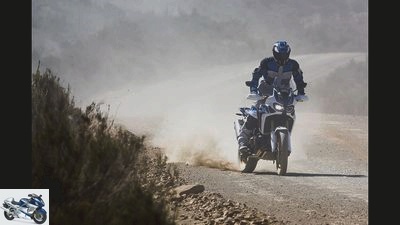
ULA SERRA PRATS
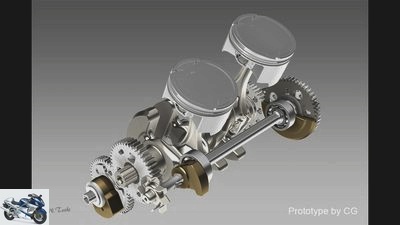
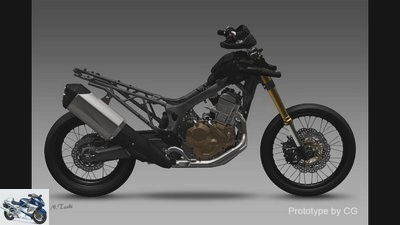
Honda
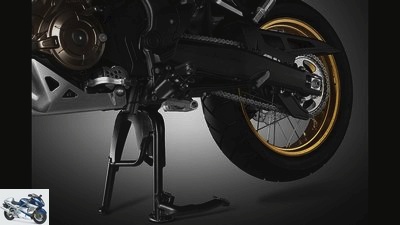
Emanuele Bella
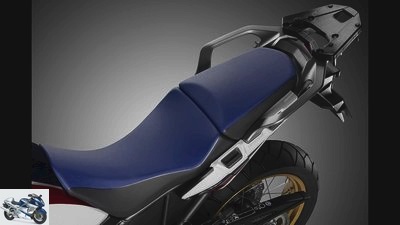
Emanuele Bella
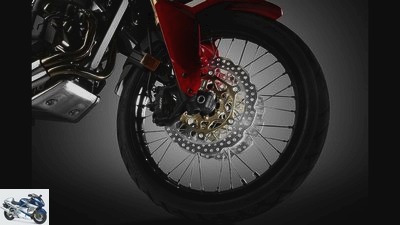
Emanuele Bella
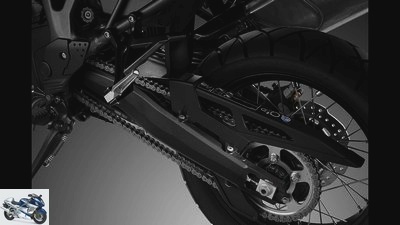
Emanuele Bella
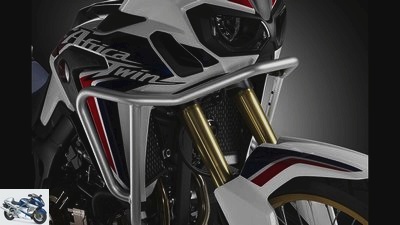
Emanuele Bella
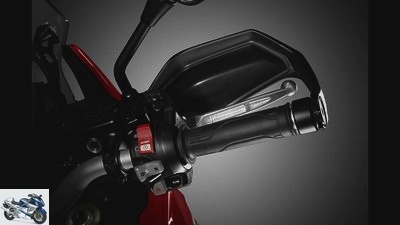
Emanuele Bella
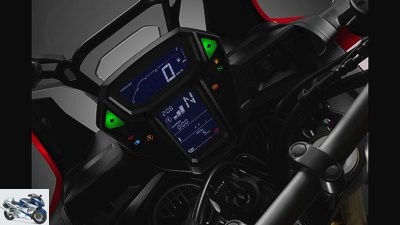
Emanuele Bella
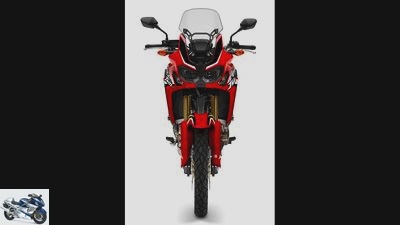
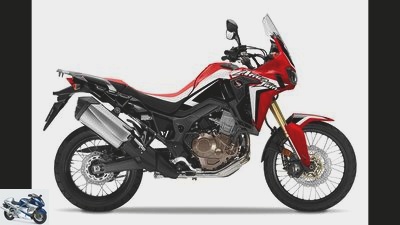
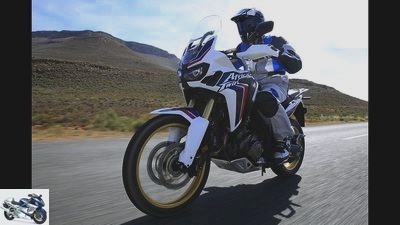
Manufacturer
Technical specifications




13 photos
Pictures: Honda CRF 1000 L Africa Twin in the driving report
To home page

ULA SERRA PRATS


Honda

Emanuele Bella

Emanuele Bella

Emanuele Bella

Emanuele Bella

Emanuele Bella

Emanuele Bella

Emanuele Bella



Manufacturer
Related articles
-
Honda CRF 1100 L Africa Twin (2020) in the driving report
Motorcycle fair in Milan EICMA 2019 Presented by Honda 14 pictures Honda 1/14 The basic model Honda CRF 1100 L Africa Twin comes exclusively with the …
-
Honda Africa Twin, KTM 1050 Adventure and Suzuki V-Strom 1000
markus-jahn.com 33 images archive 1/33 Power on the crankshaft. Measurements on the Dynojet roller test stand 250, corrected according to 95/1 / EG, maximum …
-
Endurance test Honda CRF 1000 L Africa Twin
Jorg Kunstle 39 pictures Markus Biebricher 1/39 End: Reporter Mike Schumann (left) and travel uncle Markus Biebricher (right) escorted with their private …
-
Archive pictures Honda XRV 650 Africa Twin and the driving report from MOTORRAD 09-1988
Herzog 17 pictures Herzog 1/17 The bumpier the route, the clearer the Honda can set itself apart from competitors like the BMW R 80 GS ….
-
Driving report Honda VTR 1000 time difference Japan is eight hours ahead of Germany, Honda is four weeks behind Suzuki – at least when it comes to …
-
Honda Africa Twin in the top test
markus-jahn.com 21 pictures markus-jahn.com 1/21 The first impressions of the Honda Africa Twin at its presentation were very promising. But now…
-
Driving report Honda CBR 1100 XX
Driving report, Honda CBR 1100 XX Blackbird Honda CBR 1100 XX There has been a lot of speculation in the past few weeks. Is the Honda CBR 1100 XX really…
-
Premiere Honda CRF 1000 L Africa Twin
Honda 7 pictures Honda 1/7 With a lot of ground clearance, a lot of suspension travel, good steering behavior, large steering angle … Honda 2/7 … and a slim …
-
Driving report Honda CB 1000 R 2018
Honda 20th photos Honda 1/20 The new Honda was first presented at EICMA 2017. Now we were allowed to try out the new naked bike for the first time. Honda…
-
Honda CB 650 F in the driving report
Photo: Plant 36 pictures Plant 1/36 Honda CB 650 F in the driving report. Plant 2/36 Honda CB 650 F in the driving report. Plant 3/36 Honda CB 650 F in the driving report. Plant 4/36 …